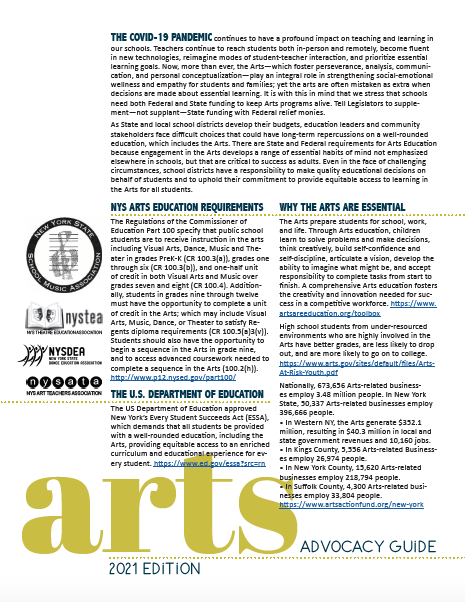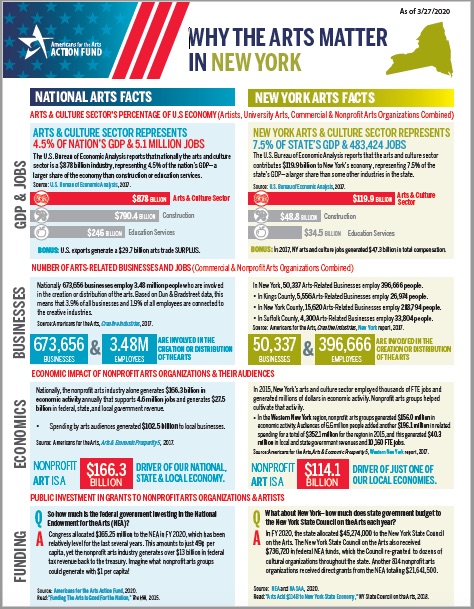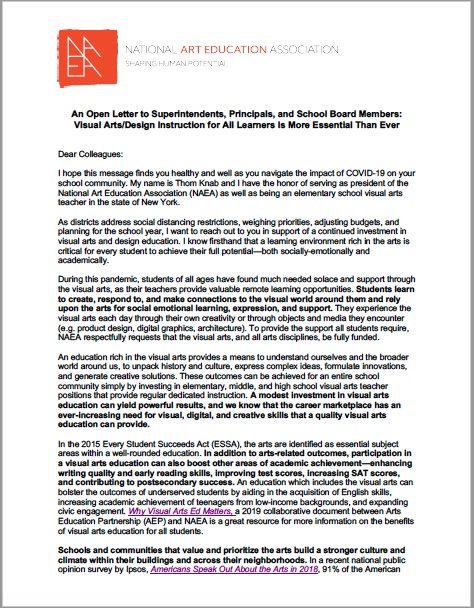|

New York State Edcuation Department (NYSED)
Regulations and Guidance
- The difference between digital art and media arts is that the media arts include a time-based component.
read more
- High school students in New York State can take a 3 or 5 unit sequence in art and they can earn a Regent's Diploma with the 4 +1 Pathway? Approved by the Board of Regents, students can take 3 units of art and then complete an AP or IB portfolio (in place of taking another Regent's exam) to earn a Regent's Diploma.
read more
- Uder No Child Left Behind (NCLB), Art was listed as a "core" subject? Now, under Every Student Succeeds Act (ESSA), Art is listed alongside Math, Reading, and other subjects as a part of a "Well Rounded Education."
read more
- Students in poverty are less likely to have access to art education in their school. The same is true for students enrolled in charter schools.
read more
- Even if Elementary Art is taught by the elementary classroom teacher rather than a certified art teacher, the curriculum must address ALL the Visual Art Learning Standards.
read more
- The U.S. Bureau of Economic Analysis reports that the arts and culture sector is a $804 billion industry, which represents 4.3% of the nation's GDP--a larger share of the economy than transportation and agriculture.
read more
- 93% of all communication is visual. And, our brains process images 60,000 times faster than text!
read more
- Students should have the opportunity to earn 1/2 unit of both art and music across grades 7 and 8. The art requirement cannot be replaced with technology and should meet all of the Visual Arts Standards for grades 7 and 8.
read more
- Courses used to satisfy the required one unit of credit for graduation should be comprehensive and foundational (e.g. Studio in Art) rather than media specific (e.g. Ceramics)? Comprehensive Foundational Courses should meet ALL the Visual and/or Media Arts Standards for the grade level; advanced electives are not required to meet ALL the standards.
read more
- Art is a required subject at the high school and middle school level, and for every grade at the elementary level.
read more
- All students must have the opportunity to begin an art sequence in grade 9 and should have access to the courses they need to choose a 3- or 5-unit sequence in art.
NYSED Regulation 100.2(h)
|

More Facts and Research about the benefits of Art Education
-
Art students are, “Taught a remarkable array of mental habits not emphasized elsewhere in schools.” Hetland, L., Winner, E., Veenema, S., & Sheridan, K. (2007). Studio thinking: The real benefits of visual arts education. New York, NY: Teachers College Press.
-
“Art helps students build the recognition, perception, sensitivity, imagination, and integration skills needed to make sense of the world around them.” Eisner, E. (2002). The Arts and the creation of mind. New Haven, CT: Yale University Press.
-
“In the 21st century global economy, the arts equip students with a creative, competitive edge. The arts provide the skills and knowledge students need to develop the creativity and determination necessary for success.” Arts Education Unified Statement (2020), NAEA.
-
"... high school students from under-resourced environments who are highly involved in the arts have better grades, are less likely to drop out, and are more likely to go on to college." Catterall, J.S., Dumais, S.A., & Hampden-Thompson, G. (2012). The Arts and Achievement in At-Risk Youth: Findings from Four Longitudinal Studies. Washington, D.C.: National Endowment for the Arts
-
"... study of the visual arts enables all learners to understand their world and the culture and history of others." #Visual Arts Matters. (2020, NAEA)
-
"...just 45 minutes of art making, at any skill level, significantly reduces stress hormones." Kaimal, G., Ray, K. & Muniz, J. (2016) Reduction of cortisol levels and participants' responses following art making. Art Therapy, 33(2), 74-80, DOI: 10.1080/07421656.2016.1166832
|
















